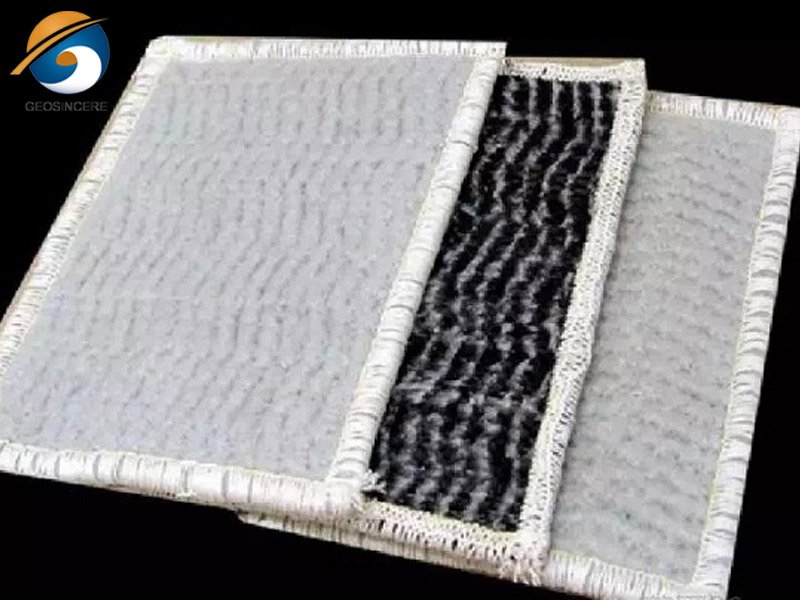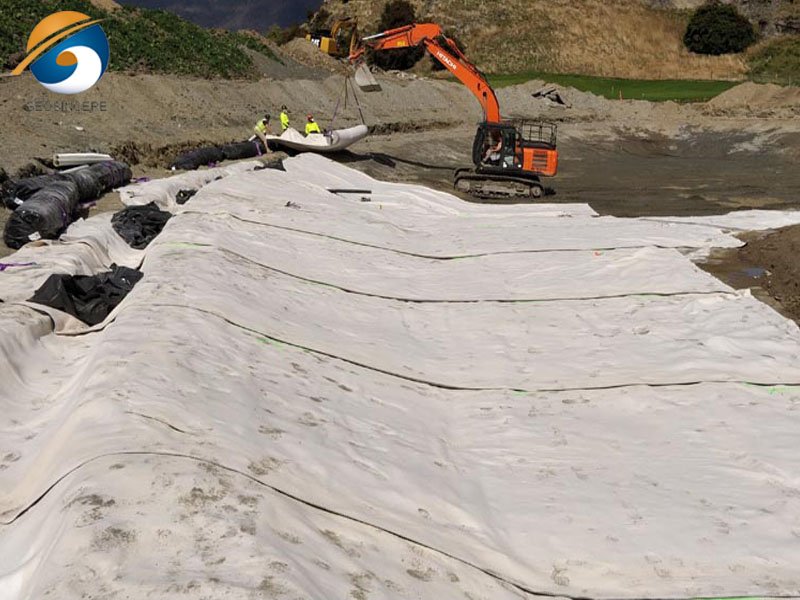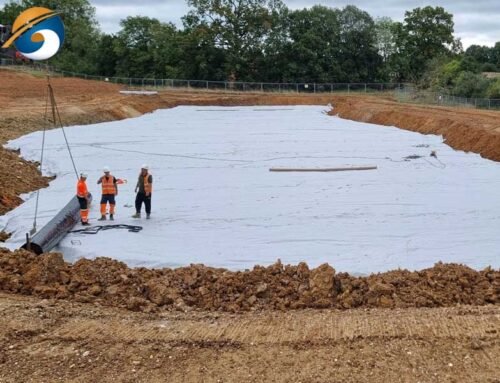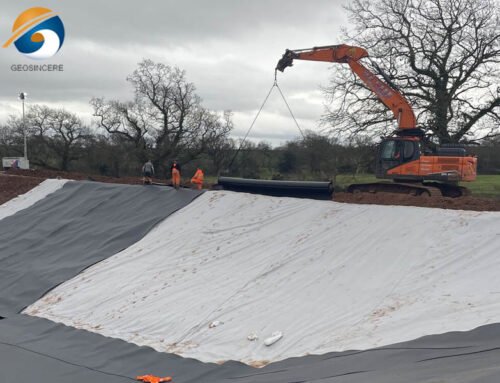As global infrastructure development and environmental engineering continue to grow, Geosynthetic Clay Liners (GCLs) have become increasingly important due to their excellent impermeability and ease of installation. GCLs are now widely used in landfill liners, mining tailings dams, artificial lakes, tunnels, water conservancy, and various containment applications.
However, the GCL market offers a variety of products with different properties, and selecting the most suitable one for your project is often a challenge for designers, engineers, and procurement professionals.
This article—written from the foreign trade perspective of GEOSINCERE, a leading geosynthetic materials manufacturer in China—offers an in-depth analysis of GCL selection principles to help international buyers make informed decisions.
1. What is GCL and Why is it Important?
GCL (Geosynthetic Clay Liner) is a composite geosynthetic product consisting of natural sodium bentonite sandwiched between two layers of geotextile (typically nonwoven and woven fabrics). These layers are reinforced by needle-punching and/or adhesive bonding.
Key Advantages:
– Excellent impermeability – Once hydrated, bentonite swells to form a dense gel layer (up to 10 mm), with a permeability coefficient as low as 1×10⁻⁹ cm/s.
– Easy installation – Lightweight, rollable, and adaptable to complex site conditions.
– Self-sealing properties – Capable of sealing minor punctures and cracks.
– Eco-friendly & cost-effective – Made of natural clay, non-toxic, and offers long-term environmental protection.


2. Common Types of GCL Liner and Their Structure
Geosynthetic Clay Liners (GCLs) come in several configurations, tailored to different engineering requirements and site conditions. At GEOSINO, we manufacture GCLs by bonding natural clay or other low-permeability mineral materials with geotextiles or geomembranes through needle-punching or stitching technology. This creates a high-performance, eco-friendly composite barrier widely used in environmental containment.
GEOSINO GCL are a new type of geosynthetic product. They are made by encapsulating a layer of natural clay or other low-permeability mineral materials between geotextiles or geomembranes through needle-punching or stitching methods.
For special engineering environments, a HDPE membrane can be laminated onto the GCL surface to further enhance impermeability, making it suitable for high-demand containment applications such as hazardous waste landfills or chemical ponds.
Depending on structural reinforcement and project conditions, GCLs can be classified into several types:
2.1 GCL Liner – Standard Needle-Punched GCL (GCL-NP)
Sodium bentonite is enclosed between a nonwoven and a woven fabric and reinforced via needle-punching. Suitable for general applications such as landscape ponds, canals, and ecological barriers.
2.2 GCL Liner – Adhesive-Bonded GCL (GCL-AD)
Adds a heat-bonded adhesive layer to improve internal shear strength. Ideal for slopes, landfills, and mining sites with gradient challenges.
2.3 GCL Liner – HDPE-Composite GCL (GCL-HDPE)
Laminated with a 0.2–0.5 mm HDPE film to enhance impermeability. Perfect for high-risk containment such as hazardous waste facilities and petrochemical plants.
2.4 GCL Liner – Reinforced GCL (GCL-R)
Incorporates reinforcement materials (e.g., fiberglass mesh or polyester grid) to boost tensile strength and performance under heavy loads or differential settlement.
3. Key Factors in GCL Liner Selection
Choosing a GCL isn’t just about thickness or price. You must consider project requirements, soil conditions, climate, and design life. Here’s a breakdown:
3.1 Project Type & Functional Purpose
| Application Area | Recommended GCL Type | Special Requirements |
| Landfills | Adhesive or HDPE-Composite | High impermeability & shear resistance |
| Industrial wastewater ponds | HDPE or Reinforced GCL | Chemical resistance & durability |
| Reservoirs & lakes | Standard or Reinforced GCL | High water pressure, settlement adaption |
| Tunnel Waterproofing | Adhesive GCL + HDPE combo | Anti-hydrostatic pressure, long life |
| Building Basements | Standard needle-punched | Simple structure, fast installation |
3.2 Soil Type & Ground Conditions
Sandy or rocky bases require composite GCLs with better resistance to water migration.
Unstable or settling foundations benefit from reinforced GCLs.
Acidic/organic soil: Use modified sodium bentonite with higher chemical compatibility.
3.3 Climate & Job Site Conditions
High/low temperature zones demand materials with stable thermal tolerance.
Humid, windy, or rainy areas require larger roll sizes and moisture-resistant packaging.
For rainy season installations, quick-install formats are key to staying on schedule.
3.4 Permeability & Bentonite Quality
High-quality sodium bentonite ensures top performance. Look for:
- Swell index ≥ 24 ml/2g
- Water absorption ≥ 600%
- Permeability ≤ 1×10⁻⁹ cm/s
Always ask for third-party lab test results when evaluating supplier quality.
4. 5 Common Mistakes Buyers Make When Purchasing GCL (And How to Avoid Them)
Through years of cooperation with clients worldwide, we at GEOSINO have identified some frequent errors buyers make when sourcing GCL. Avoiding these mistakes can save time, money, and project risk.
4.1 Mistake 1: Only focusing on bentonite weight
- Reality: GCL weight alone doesn’t determine performance. The geotextile type, needle-punching density, and bonding method are equally important.
- Tip: Request full specs including tensile strength, peel strength, and geotextile composition.
4.2 Mistake 2: Chasing the lowest price without assessing quality
- Reality: Cheap GCL may contain recycled fabrics or low-grade clay, causing early leakage. Repairs cost far more than premium materials.
- Tip: Choose suppliers with certifications (ISO, CE, SGS) and verifiable export records.
4.3 Mistake 3: Ignoring packaging & shipping protection
- Reality: GCL is sensitive to moisture. Without waterproof wrapping and pallets, it may hydrate during transit and become unusable.
- Tip: Insist on dual-layer plastic wrapping + woven bag + wooden pallet + loading photo.
4.4 Mistake 4: Copying GCL specs from other countries or projects
- Reality: Site conditions vary by region. For example, in desert areas like the Middle East, GCL may expand or warp under thermal changes; tropical zones need fast-install formats due to rain.
- Tip: Always tailor specs to local soil, weather, and slope. Ask your supplier for a custom suggestion.
4.5 Mistake 5: Not understanding customs or certification requirements
- Reality: Some countries (e.g., South Africa, Saudi Arabia) require SABS/SASO/SONCAP certificates. Failure to prepare leads to delays or fines.
- Tip: Work with an experienced exporter like GEOSINO who can provide CO, MSDS, SDS, Test Reports, and more.
5. How to Evaluate GCL Liner Product Quality?
5.1 Manufacturing Process
- Premium sodium bentonite (high montmorillonite content)
- Uniform needle-punching
- One-step HDPE lamination
- Fully automated QC systems
5.2 Certifications & Export Experience
- ISO 9001/14001
- CE / SGS / BV / SANS
- Ability to handle cross-border documentation and inspection
5.3 Technical Support
GEOSINO provides:
- Project design matching
- Engineering drawings & install guidance
- Free samples & third-party test results
- Export logistics, customs documentation, after-sales support


6. Why Choose GEOSINO?
As a trusted supplier of geosynthetics from China, GEOSINO offers:
Fast delivery: Over 300,000 m² GCL stock ready for shipment within 7 days
Top-quality bentonite: Montmorillonite content up to 98%
Global service: Customers in 50+ countries across South America, Africa, Asia, and the Middle East
Engineering support: Free layout suggestions, drawings, and customization
Multilingual sales team: English, Spanish, French, Arabic available
7. Conclusion: A Smarter Approach to GCL Selection
Choosing the right GCL is not just a technical decision—it’s a commitment to project safety and environmental responsibility. At GEOSINO, we’re here to guide global buyers toward smart, sustainable, and effective waterproofing solutions.
Contact us today for technical data, free samples, or price quotes.





